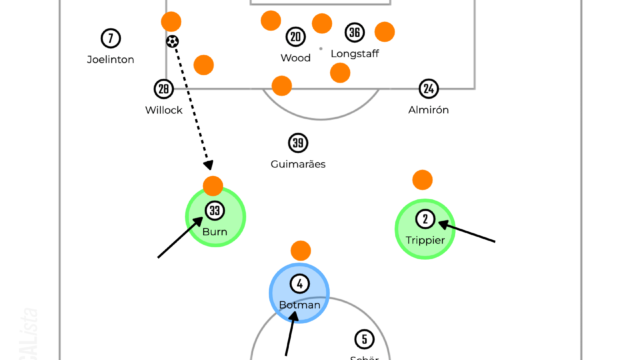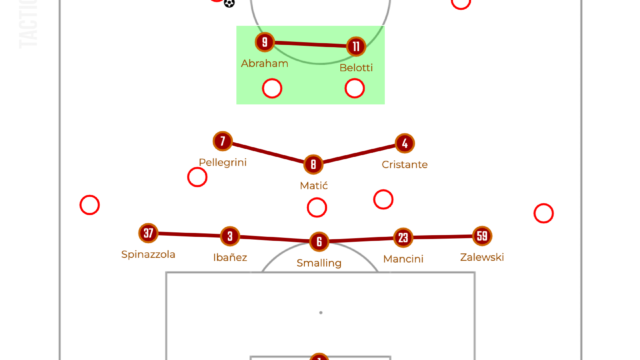Thomas Frank’s Tottenham Hotspur Tactical Analysis 25-26

In this article, the tactics of Tottenham Hotspur under their new manager Thomas Frank is going to be analysed based on their preseason games towards the 25-26 season.
Out of Possession
Unlike my usual articles, this time, their tactics out of possession are going to be analysed first because they are much better when they do not have the ball.
High Pressing
When they press high up the pitch, especially against the opposition goal kicks, they prefer man to man approach and match up their shape against the opposition. The only goal they scored against Newcastle is the greatest example.

The left winger Son applied pressure on the opposition right centre back and at the same time, the left fullback Davies and centre back Danso jumped to catch the opposition right fullback and winger respectively to make it man to man in the ball side. In addition to them, the midfielders around the ball, Gray and Sarr stayed close to the opposition deep midfielders so that Schär could only play either of Murphy or Tripper, who were just being pressed from their back. Danso won the ball and Johnson, who tucked in to create an overload, recovered it and struck it into the back of the net.
This is a great example of mixing man to man and zonal approach, in which the players around the ball mark the opponents tightly and the players on the opposite side narrow in to create an overload around the ball. However, things cannot go as easy as this from the beginning of the new era.
The goal conceded against them came from the error of high pressing. Like when they scored, they went man to man in the same way, but Newcastle beat it quite well and quickly threatened the goal.

The ball side players actually applied pressure in the similar way and Schär played into Murphy, déjà vu. The difference is whether Danso could win the duel against him or not. He was delayed to press on him and let him play to Joelinton, who laid the ball off to Guimarães, then eventually the ball was delivered to Barnes who equalised the game.
When pressing with man to man approach, the delay of a second really matters and it often happened especially against Bayern Munich.

This is a similar example to what happened against Newcastle. This time, the other centre back Van de Ven couldn’t close Olise down at the proper moment, which gave him time to turn forwards and play the through ball to Coman.
As it was discussed, Tottenham need more intensity when pressing man to man and it might be the problem of individuals. Therefore, it is difficult to change quickly, so we need to be patient in this area. However, we don’t need to worry because from the midfield to defensive third, they are extremely well organised and let’s find out their detailed zonal blocks in the following chapter.
Middle Pressing
In the midfield, they set a compact and zonal 4-4-2 defensive block, but it seems more like a 4-2-4 as the wingers tend to stay high to press on the opposition centre backs. Their biggest characteristic is their strong intention to keep the shape as compact as possible by pushing the lines up.

The image shows the situation when they pushed the back line quickly to leave Arsenal attackers in the offside position. This is the basis of their strategy from the midfield to defensive third.
After nullifying the space in behind and closing the gap between the lines, it is time to press. Unlike a traditional 4-4-2, it is mainly the wingers’ job to press on the opposition defendiers. So, the forwards stay deep to look after the opposition defensive midfielders instead of jumping on the opposition defenders.

This is how they won the ball against Arsenal in the deep midfield area. The left winger Odobert pressed on the ball and Bergvall, who was a part of the front two out of possession, dropped deep to close the passing lane to the opposition midfield.
This tendency of “wide players pressing and central players covering” continues in the defensive third.
Final Third Defending
When protecting the box, they follow the strict basis of zonal defending.

The illustration above shows their basis of defending the box, which can be divided into three parts. The first one is around the ball, where the fullback and winger aggressively press on the ball while the ball side defensive midfielder covers the space between the fullback and centre back. The second one is in front of the goal, where three remaining defenders plus the other defensive midfielder wait to deal with a cross. The last one is the front two and opposite winger who cover the space in front of the box to close the possible route towards the middle and secure the second balls after clearing a cross.
In addition to this basis, they are still eager to push the back line up to make the space in behind unavailable for the opposition.

The image above illustrates the situation when the defenders pushed the back line up to leave Gordon, who met the cross and found the back of the net, in the offside position. As soon as the ball was played back from Trippier to Murphy, they collectively stepped higher to push the back line up. This was great team work and it is possible to guess that Thomas Frank made so much effort in this area.
On the flip side, the zonal structure can leave space for the opposition.

The space between the ball side triangle and the diamond in front of the goal can be open for the opposition and Newcastle smartly exploited the space. In this example above, the striker Gordon made a curved run from the middle to receive the ball from Murphy. Gordon would have been marked if Danso followed the instruction of man marking, but he chose to stay in his position based on the zonal approach. Like this, Tottenham’s zonal structure can protect the vital spaces but it is impossible to defend everywhere on the pitch, and this space where Newcastle exploited can be their weakness in the final third.
Overall, the zonal defending from the midfield and defensive third is well organised by Thomas Frank and would work against possession based teams like Man City or Chelsea, but maybe they’ll struggle when they want to press high with man to man approach. Thomas’s job to mix man to man and zonal approach is worth carefully watching.
In Possession
Build up
To be honest, after Maddision’s injury which forced him to be out of the squad for most of the season, it is difficult for them to play out from the back against elite pressing teams. They play with the trending 4-4-2 with two wingers high and front two dropping to receive in between the lines, but no players are able to play like Maddison to receive the ball in the middle. Sarr is a more deep midfielder and Bergvall needs more time to develop. Richarlison and Tel cannot move across the pitch to receive the ball or hold it up enough.
Therefore, the remaining route to progress is through the wide channels, but it becomes easier for the opposition to lock them in.

This is the example where Arsenal easily locked Spurs in the ball side. As they cannot be patient at the back and play through the middle with Bentancur or Sarr, the ball is often smoothly guided to the wide areas where the opposition want it to be.

This is the game against Bayern, and this time also they were forced to play towards the touchline quickly.

If the ball is in the wide areas, it becomes easier for the opposition to read where the ball would be played next due to the lack of the options. Like this, the pass from Spence to Johnson was anticipated by Upamecano and intercepted.
Right now, there are rumours that Spurs are targeting Savinho or Eze. I think this is because they need wingers who can keep the ball and progress from the wide areas. Their profile can match what they need as they only have runners like Johnson or Odobert, Kudus can handle the ball well though.
Final Third Attacking
As they have no options to play into the middle, their threat can only come from wide areas. They play in behind the opposition fullbacks and the agile and quick wingers chase it.

The illustration above shows the situation when they played around and exploited the space behind the opposition left fullback by the pass from Porro to Johnson. This is the main and only option they can threaten the opposition defensive structure.

In the illustration above, against Arsenal whose defensive midfielders tracked Tottenham’s attacking midfielders, it seems possible to exploit the space in between the lines as the opposition defensive midfielders are far away from each other. If there is a striker who can drop to create an option to play inside, they can have some variations to progress. However, as you can see, they kept focusing on playing down the wing.
Although Kudus, Johnson or Odobert can be dangerous threats, it is impossible to rely on this throughout the season. They need more solutions to play through the middle and for sure, it requires some new players who can replace Maddison.


